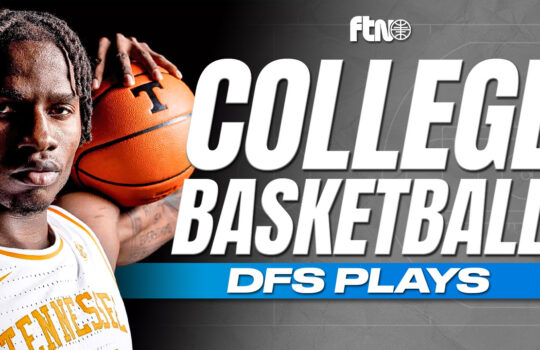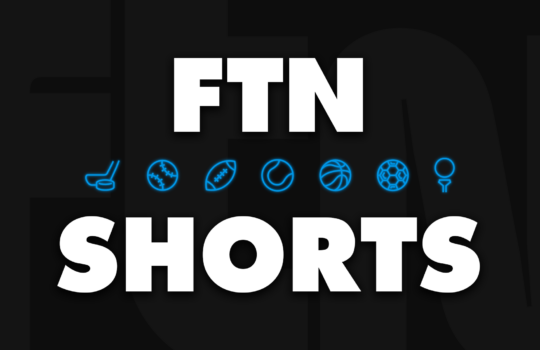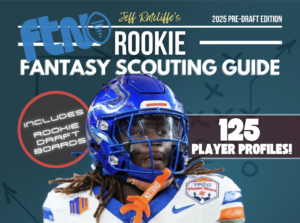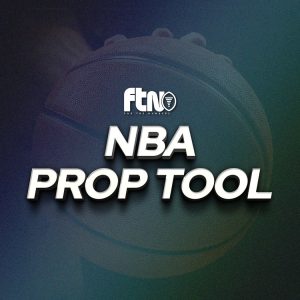
I’ve spent the last month discussing how I’ve been differentiating myself from the field by finding ways to get unique without being stupid and still drafting plus-EV teams.
In a large-field tournament like Best Ball Mania, consisting of 672,672 total entries, it’s critical to go off the board a bit and implement unorthodox strategies that may feel uncomfortable. Earlier this offseason, I broke down some of my favorite backfields to pair together, considering drafters are often hesitant to draft their own handcuffs. I explained the flaw behind this sort of mindset with the current landscape of the running back position and fewer teams opting to use a true three-down bell-cow.
Although drafting two backs from the same team is underutilized by the field, it’s even more uncommon at the tight end position and a lot harder to execute. With the rate of 12 personal or two tight-end sets continuing to decline, this strategy is only applicable for a handful of teams, which I’ll break down shortly. When drafting two tight ends from the same team, I want to target players who will see the field together with stand-alone value and contingent upside. For example, I used the Saints’ tight end room as a target last season, with Taysom Hill and Juwaan Johnson. In 2023, Hill finished as the TE10 in half-PPR scoring and averaged just shy of eight points per game (7.8), but he was the perfect “better in best ball” archetype due to his boom/bust nature. Through 15 games in Weeks 1-17, Hill finished as a top-10 tight end 40% of the time (6 out of 15 games) and posted the exact same number of finishes ranked outside the top-24 at the position (6 out of 15 games, 40%).
Johnson, on the other hand, missed significant time due to injuries but came on strong in the back half of the season. He finished as a top-10 tight end in three consecutive games from Weeks 15-17 and found the end zone with double-digit half-PPR points in each outing. His 14.2 half-PPR points per game led all tight ends during that span and was TE4 in the fantasy semifinals (12.8 half-PPR points) and TE1 in championship week with almost 20 half-PPR points (19). Although you can only start one tight end, Johnson’s breakout performance didn’t seem to hinder Hill, who finished as the TE8 in Week 17, respectively, with a receiving touchdown of his own.
Unfortunately, with Hill no longer being tight end eligible on Underdog, he won’t be included in this article but should be a priority target in other best ball formats with the proper positional designation. You’ll notice that there are two quote-on-quote “elite” tight ends on this list, that either force you to eat zero or spend even more capital on the position. There isn’t a right or wrong way to handle this situation, but if drafting a third tight end with a top-five option, I prefer to push it as late as possible, ideally beyond the first 14 rounds, if not your final pick.
Baltimore Ravens
Mark Andrews – ADP: 48.7, TE4
Isaiah Likely – ADP 176.2, TE22
Mark Andrews and Isaiah Likely were a tight end pairing I touched on last season in the new Todd Monken offense, and I was hoping to see a high rate of 12-personal, similar to his utilization of Brock Bowers and Darnell Washington back in Georgia. Unfortunately, we did not get much of a sample with both Ravens tight ends seeing the field at the same time last season. Andrews missed significant time from the start and was ruled out of the season-opener with a quad injury, and missed the last six games with a fractured fibula. Although he was activated off the injured reserve list ahead of the AFC Championship, Andrews primarily operated as a decoy against the Chiefs and ran a route on just 26% of Lamar Jackson’s dropbacks. He caught both of his targets for 15 scoreless yards. Andrews was a brutal draft pick for fantasy last season but showed flashes of TE1 overall upside when healthy. He fit like a glove in the new Monken system and led Baltimore with a 24% target share in Weeks 2-9. He averaged 6.6 targets, 4.8 receptions, 57.9 receiving yards and 0.7 touchdowns in nine healthy games playing beyond the first quarter. His 12.2 half-PPR points per game with a full complement of snaps would have ranked first among all tight ends last season. No player benefited more than Likely in the absence of Andrews, who was even more productive than his counterpart once he took over as the starter from Week 12 on.
Over the last five games of the regular season, with Jackson and the rest of the starters active, Likely became a focal point of the offense and posted a 17% target share, behind only Zay Flowers (22%) for second on the team, and averaged 5.2 targets, 3.8 receptions, 58.2 receiving yards, 0.8 touchdowns and 12.5 half-PPR points during that span. He played a critical role in the red zone and scored six times in his last six games without Andrews, including the playoffs, and a meaningless Week 18 game, despite playing less than 20 snaps (19). With last season’s free agent acquisition Odell Beckham no longer on the team, that leaves behind a thin and unproven receiving corps, and it wouldn’t be shocking to see Andrews and Likely share the field as co-starters this upcoming season. Andrews should still be the favorite as the No. 1 target, but Likely may not be far off and could potentially compete with Flowers as the No. 2.

Buffalo Bills
Dalton Kincaid – ADP: 51.2, TE5
Dawson Knox – ADP: 212.8, TE31
There are a lot of question marks surrounding the Bills offense in 2024. With their top two leading receivers Stefon Diggs and Gabe Davis no longer on the team, there’s a significant void to fill without much of a proven track record on the current depth chart. Dalton Kincaid, a 2023 first-round pick, looks poised for a second-year breakout after setting a franchise record in receptions by a rookie with 73 grabs on 90 targets, which trailed only Diggs for second on the team in both categories. As great as Kincaid was, he really didn’t get going until Dawson Knox was forced out of action due to a wrist injury.
Despite trading up for Kincaid in last year’s draft, the Bills had no intention of getting their incumbent starter off the field, who had recently signed a hefty extension and out-snapped the rookie tight end 270-242 in the first five games. Once Knox went down in Week 7, Kincaid immediately became one of Josh Allen’s go-to options and caught all eight of his passes for 75 yards with 11.5 half-PPR points on the day. With Knox out, Kincaid finished as a TE1 in five out of six games and saw 7.5 targets per game on 6.5 receptions for nearly 60 yards (59.3) and 11.2 half-PPR points during that span. Kincaid’s production took a significant hit with Knox back in the lineup following the break, and he played on less than 60% of the Bills’ offensive snaps in five of the last six games, including the playoffs. However, in 12 games with both tight ends available, Buffalo ran out of 12 personnel at the third-highest rate in the league (26%), a number that should only increase without Diggs and Davis this upcoming season. Kincaid looks to be the runaway favorite to replace Diggs as the top target in the offense, with Knox being the more volatile of the two. It makes for an intriguing late-round dart throw, since he should provide a handful of spike weeks. Since entering the league in 2019, Knox has a career 12.8% career touchdown rate and has scored six-plus touchdowns in each of his last two seasons playing more than 12 games.
Green Bay Packers
Luke Musgrave – ADP: 147.9, TE17
Tucker Kraft – 214.2, TE33
The Packers double-downed on tight ends on Day 2 of the 2023 NFL Draft when they selected Luke Musgrave in the second round, followed by Tucker Kraft in Round 3. As the first tight end selected, Musgrave had a commanding hold on the starting gig, and more than doubled Kraft in snaps over the first half of the season. He finished as a TE1 in four of his first eight games, excluding Week 4 where he exited after just 14 snaps due to a concussion, and averaged nearly 40 receiving yards during that span. With Musgrave active, Kraft was almost a non-factor in the passing game and saw zero targets in seven out of his first eight games.
However, once Musgrave went down with a lacerated kidney in Week 11, Kraft finally got the opportunity to showcase himself and rarely ever left the field. He operated as a near-every down player. In six games without Musgrave, Kraft finished as a top-10 tight end twice and averaged 46.8 receiving yards in Weeks 12-17. He did just enough to hold on to the starting role even once Musgrave was cleared to return and maintained a significant lead throughout the postseason. Over their last three games together, including the playoffs, Kraft out-snapped Musgrave 156-43, which creates an interesting dilemma heading into the offseason. There’s no telling how the tight end room will shake out in Green Bay, but both tight ends flashed enough in their first season to warrant more playing time, especially under head coach Matt LaFluer, who has historically leaned into a committee approach.
Speaking of deploying the two together in certain weeks:

















































 New York Jets
New York Jets  New England Patriots
New England Patriots  Miami Dolphins
Miami Dolphins  Buffalo Bills
Buffalo Bills  Pittsburgh Steelers
Pittsburgh Steelers  Cleveland Browns
Cleveland Browns  Cincinnati Bengals
Cincinnati Bengals  Baltimore Ravens
Baltimore Ravens  Tennessee Titans
Tennessee Titans  Jacksonville Jaguars
Jacksonville Jaguars  Indianapolis Colts
Indianapolis Colts  Houston Texans
Houston Texans  Las Vegas Raiders
Las Vegas Raiders  Los Angeles Chargers
Los Angeles Chargers  Kansas City Chiefs
Kansas City Chiefs  Denver Broncos
Denver Broncos  Washington Commanders
Washington Commanders  Philadelphia Eagles
Philadelphia Eagles  New York Giants
New York Giants  Dallas Cowboys
Dallas Cowboys  Minnesota Vikings
Minnesota Vikings  Green Bay Packers
Green Bay Packers  Detroit Lions
Detroit Lions  Chicago Bears
Chicago Bears  Tampa Bay Buccaneers
Tampa Bay Buccaneers  New Orleans Saints
New Orleans Saints  Carolina Panthers
Carolina Panthers  Atlanta Falcons
Atlanta Falcons  San Francisco 49ers
San Francisco 49ers  Seattle Seahawks
Seattle Seahawks  Los Angeles Rams
Los Angeles Rams  Arizona Cardinals
Arizona Cardinals 





 Boston Celtics
Boston Celtics  Brooklyn Nets
Brooklyn Nets  Philadelphia 76ers
Philadelphia 76ers  New York Knicks
New York Knicks  Toronto Raptors
Toronto Raptors  Chicago Bulls
Chicago Bulls  Detroit Pistons
Detroit Pistons  Milwaukee Bucks
Milwaukee Bucks  Cleveland Cavaliers
Cleveland Cavaliers  Indiana Pacers
Indiana Pacers  Orlando Magic
Orlando Magic  Atlanta Hawks
Atlanta Hawks  Charlotte Hornets
Charlotte Hornets  Miami Heat
Miami Heat  Washington Wizards
Washington Wizards  Denver Nuggets
Denver Nuggets  Minnesota Timberwolves
Minnesota Timberwolves  Oklahoma City Thunder
Oklahoma City Thunder  Portland Trail Blazers
Portland Trail Blazers  Utah Jazz
Utah Jazz  LA Clippers
LA Clippers  Golden State Warriors
Golden State Warriors  Los Angeles Lakers
Los Angeles Lakers  Phoenix Suns
Phoenix Suns  Sacramento Kings
Sacramento Kings  Dallas Mavericks
Dallas Mavericks  Houston Rockets
Houston Rockets  Memphis Grizzlies
Memphis Grizzlies  New Orleans Pelicans
New Orleans Pelicans  San Antonio Spurs
San Antonio Spurs 












